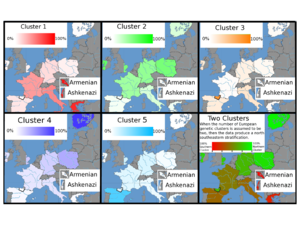
Ancestry-informative marker
Encyclopedia

By using a number of AIMs one can estimate the geographical origins of the ancestors of an individual and ascertain what proportion of ancestry is derived from each geographical region. By using a suite of these markers more or less evenly spaced across the genome, they can be used in a cost-effective way to discover novel genes underlying complex diseases in a technique called admixture mapping
Admixture mapping
Admixture mapping is a method of gene mapping that makes use of a population of mixed ancestry to find the genetic loci that contribute to differences in diseases or other phenotypes found between the different ancestral populations...
or mapping by admixture linkage disequilibrium.
There are an estimated 15 million SNP sites (out of roughly 3 billion base pairs, or about 0.4%) from among which AIMs may potentially be selected.
As one example, the Duffy
Duffy antigen
Duffy antigen/chemokine receptor also known as Fy glycoprotein or CD234 is a protein that in humans is encoded by the DARC gene....
Null allele (FY*0) has a frequency of almost 100% of Sub-Saharan Africans, but occurs very infrequently in populations outside of this region. A person having this gene is thus more likely to have Sub-Saharan African ancestors.
Collections of AIMs have been developed that can estimate the geographical origins of ancestors from within Europe.
Charles Rotimi, of Howard University's National Human Genome Center, is among those who have highlighted the methodological flaws in such research — that "the nature or appearance of human genetic clustering
Human genetic clustering
Human genetic clustering analysis uses mathematical cluster analysis of the degree of similarity of genetic data between individuals and groups to infer population structures and assign individuals to groups that often correspond with their self-identified geographical ancestry...
(grouping) is a function of how populations are sampled, of how criteria for boundaries between clusters are set, and of the level of resolution used" all bias the results — and concluded that people should be very cautious about relating genetic lineages or clusters to their own sense of identity. (see also Race)

